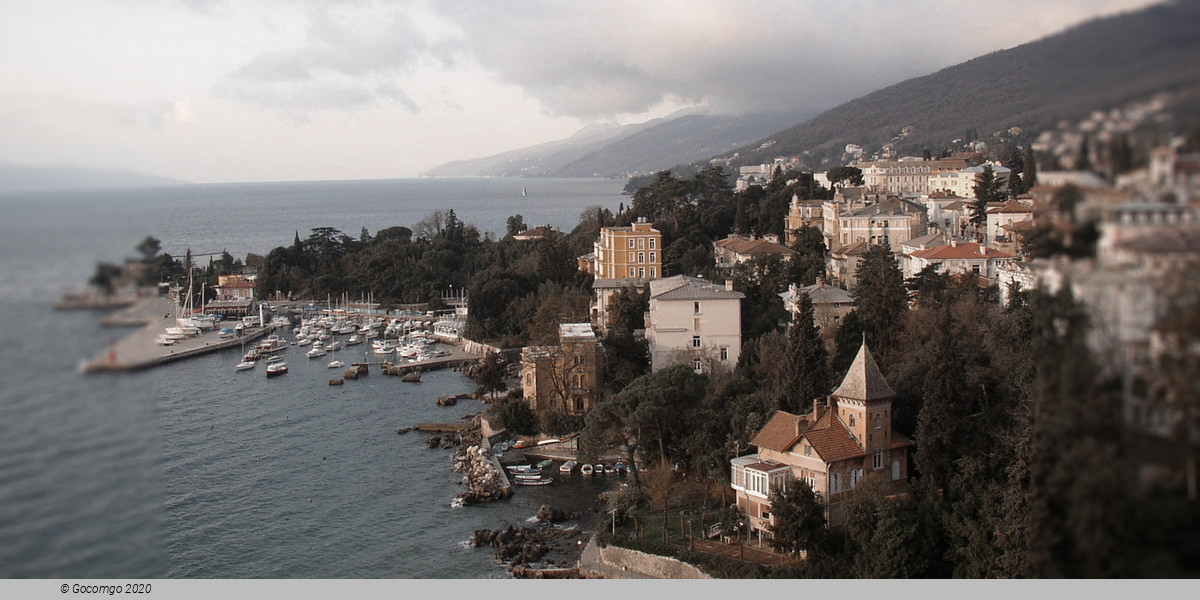Opatija

Opatija is a town and a municipality in Primorje-Gorski Kotar County in western Croatia. The traditional seaside resort on the Kvarner Gulf is known for its Mediterranean climate and its historic buildings reminiscent of the Austrian Riviera.
History
Opatija was included in the territory of the Liburni, a pre-Roman Illyrian tribe. In Roman times, the area was home to several patrician villas connected to the nearby town of Castrum Laureana, the modern Lovran.
Croats settled in the region from about 700 AD onwards. Conquered by King Pepin of Italy, son of Charlemagne, in 789, the Istrian peninsula up to the Kvarner Gulf was incorporated into the Carolingian March of Friuli by 803. In the east, it bordered on the medieval Kingdom of Croatia established by King Tomislav about 925. Having invaded Italy, King Otto of Germany made the part of the Istrian land of the vast March of Verona and Aquileia; from the 11th century onwards, the Imperial estates were held by the Patriarchs of Aquileia.
In the Middle Ages, the current town's territory was divided between Veprinac (now a locality of Opatija, perhaps home to a small fishing port) and Kastav, where the fisherman village of Veprinac. The small hamlet of Opatija itself developed around a Benedictine abbey dedicated to Saint Jacob, which was first mentioned in 1453. While western Istria was gradually conquered by the Republic of Venice by 1420, the remaining territory up to Opatija fell to the House of Habsburg and later was incorporated into the Austrian Littoral.
The town's modern history began in 1844, when Iginio Scarpa (1794–1866), a wealthy merchant from Rijeka, had the Villa Angiolina manor built in an extended park, where he received notable guests such as Ban Josip Jelačić. In 1873 the Austrian Southern Railway company from Vienna opened the branch line from Pivka to Rijeka via nearby Matulji and thus opened the path for the development of tourism in Opatija and neighboring Lovran. In 1882, the railway company purchased the Villa Angiolina, where it accommodated the crown prince couple Rudolf and Stéphanie. At the time, Friedrich Julius Schüler (1832–1894), the Managing Director of the Southern Railways, started the construction of the Hotel Quarnero (Kvarner Hotel) and the Hotel Kronprinzessin Stephanie (present-day Hotel Imperial), and also was responsible for the unique lungomare and parks (the Company engaged Carl Schubert, director of the Viennese Emperial-Royal Society for the construction of parks). The Villa Angiolina was later run by the Compagnie Internationale des Wagons-Lits. In the Angiolina Park, today stands Schüler's bust, a work of the sculptor Hans Rathausky.
In 1887, Heinrich von Littrow established the "Union Yacht Club Quarnero" in Opatija (founded in June/July 1886); this was the first sailing club on the Adriatic coast. In 1889 the Cisleithanian government officially declared Abbazia (Opatija) the first climatic seaside resort (Seebad) on the Austrian Riviera, rivaled by Brioni, Duino, Grado, and Portorož. After the hotels, the building of villas started, for the needs of more demanding noble guests. The first Villa Amalia, in the immediate vicinity of the Hotel Quarnero, was built in 1890 as the hotel's annex. Opatija's first guide was published in 1883 in Vienna with the title Abbazia, Idylle von der Adria. The same year saw the publication of Abbazia und seine Umgebung (Opatija and its Environs) by Heinrich Noe, who in 1884 published his Tagebuch aus Abbazia (Diary from Opatija). Joseph Rable printed Curort und Seebad Abbazia (Spa and the bathing beach in Opatija), and Peter von Radics wrote a guidebook simply titled Abbazia.
In 1908 a tramway line was opened, running from Matulji station along the coast via Opatija down to Lovran in the south. Opatija is best known nowadays as the venue for a 1912 chess tournament devoted to the King’s Gambit. The Austrian emperor Franz Joseph I used to spend several months there during the winter. He met there with the German emperor Wilhelm II on 29 March 1894; other crowned heads seeking relaxation included Empress Elisabeth of Austria and the German empress Augusta Victoria, King Carol I of Romania and his consort Elisabeth, King George I of Greece, King Albert of Saxony, Grand Duke William IV of Luxembourg, and Prince Nikola I Petrović-Njegoš. Many of the late 19th-century luxury hotels and villas have survived to present times.
During World War I the Hotel Icicii was converted to a military hospital. The accompanying pictures show the nursing staff and wounded at lunch, on the grounds, and receiving care. In 1920 Opatija was assigned to Italy. Two years later, with the advent of Fascism, the Italian government started a program of forced Italianization of the population, and most of the public positions were assigned to Italian-speaking citizens. The upper floor of Villa Amalia was built in 1930, and the building was renovated to become the summer residence of the House of Savoy.
In 1947 Opatija was given to Yugoslavia as part of the peace treaty with Italy; most of the Italian-speaking population, whose percentage had substantially increased in the past years, emigrated to Italy. In 1963 the Hotel Adriatic, by the architect Andrija Cicin-Sain and his team was completed. Hotel "Adriatic" was the first hotel built in Opatija after the Austro-Hungarian era. The rooms of the hotel "Adriatic" have been described as novelties in the hospitality industry. The "Casino Rosalia" was opened in Opatija – the first casino in Eastern Europe. In 1981 the Hotel "Admiral" and marina (200 berths and 40 dry berths) were completed. After the breakup of Yugoslavia which began in 1991, the town became part of Croatia.

